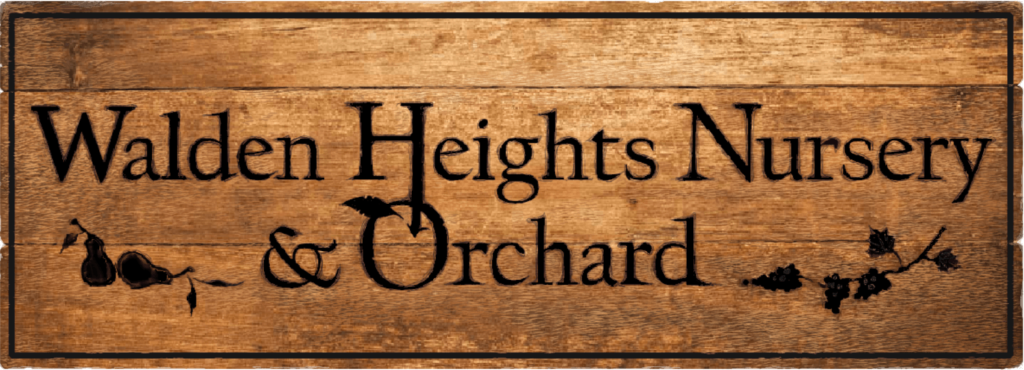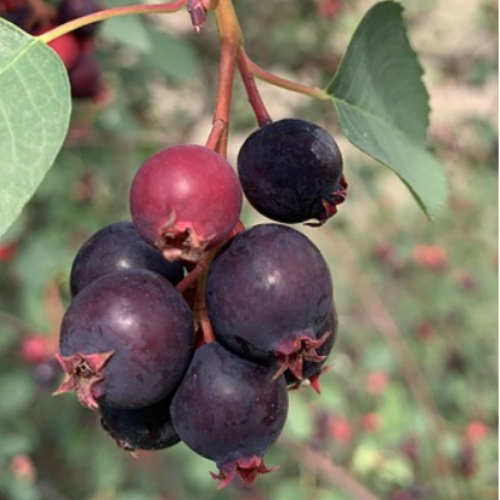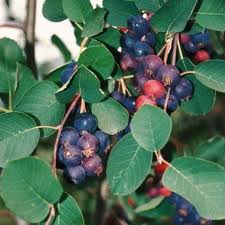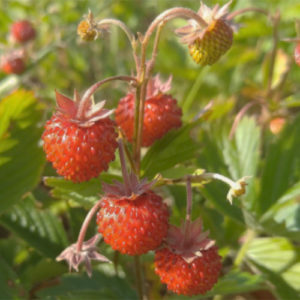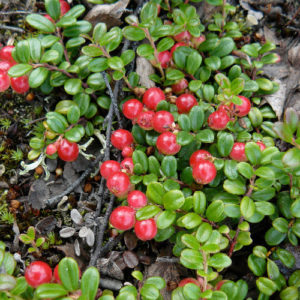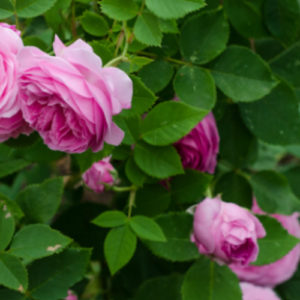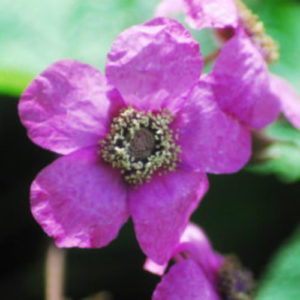EACH ORDER CONTAINS 2 PLANTS to insure pollination.
Amelanchier alnifolia - rose family (alnifolia means “leaves like alder”) also known as rocky mountain blueberry, western serviceberry, mountain juneberry, but can be confused with other amelanchiers. Saskatoon comes from the Cree name for the fruit (miss ask qua too mina).
The plant: This is a native shrub of the northwestern US , southern Alaska, and the Canadian prairies. Very cold hardy (zone 3 and perhaps zone 2) with fruit buds surviving 76 below zero F. It grows between 6 and 10 feet tall (some have grown impressively larger but it is rare). Growth is about 9 inches per year. The species can produce an impressive amount of fruit. It is unfortunate that this species is not more widely grown, as the fruit is healthy and delicious and the plant attractive. It suckers well (stoloniferous) and thus can make a good edible hedge. Tolerates tough climates and alkaline soils. It is growing very nicely here on our gravely acidic hillside. Requires 2100 chilling hours. Best in areas with average rainfall minimum of 340mm precipitation. Crops generally begin at 2-3 years old, often a year from our nursery plants. As with most fruits, preventing fruiting by blossom removal in the earlier years will significantly increase the growth (vigor) of the plants and likely contribute to a healthier planting. Patience will win out here folks. Full production is 6 to 8 years. Average yields are 6 to 10 pounds beginning at full production. Some 15 year old bushes have set nearly 30 pounds, but these are lilely exceptions. (12,000 to 20,000 lbs per acre when planted 880 plants to the acre). Which is a lot of pies. Harvest is 45 to 60 days from bloom. Although saskatoons are self fruitful, increased set and sizing has been reported in planting a variety. 20 percent of blossoms prevented from cross pollinating still set fruit in some studies. A higher percentage of seeds was noticed in cross pollination. Wild insect populations have been indicated as more of importance to pollination in Saskatoon than the honeybee, since there are reports of its disinterest in the blooms. There may be wind pollination involved as well, but limited to close flowers as the pollen is sticky and clumping. Plant lifespan is 30 to 50 years, with reports of older ones. The flower buds form on the new growth, and these buds will put forth flowers the following year, opening in May or June depending on locale. The cluster will contain between 1 and 20 flowers which will give rise to 1-20 fruits with proper fertilization. The bloom can last from 3 to 20 days. Foliage is often tinted in the early and late season with pretty, subtle pastel colors but are a matt green during the main course of the growing season.
The fruit : Not a true berry, it is actually a miniature pome, think a wee apple. The fruit is blueberry-like in appearance, turning black a tender when fully ripe, but may be eaten a bit early when at a tarter firm stage. Measure 1/3 to ½ inch diameter. Fruit does not ripen at once, so multiple pickings will allow for longer harvests- perfect for backyard growers. It is mild and distinctive, but subtle and very agreeable. The little seeds (1-10 per fruit) within impart a bit of almond flavor (like all in this genus) to the mix. I understand it makes an unbeatable fruit pie. The harvest can be stripped with the fingers, or cut with scissors, as the fruit hangs on much longer stems than a blueberry does.
Nutrition Info: per 100 gms Energy 84.84 Ca 51 Protein 1.33 g Carbohydrate 18.49 g Total Lipid (fat) .49 g Total Fibre 5.93 g Vitamin C 3.55 mg Iron .96 mg Potassium 162.12 mg 54 Vitamin A 35.68 IU **High in antioxidants.
Growing issues : - All amelanchiers are prone to leaf spot, which typically shows up in mid to late summer. It can be managed with organic sprays, but we do nothing to our plants, even when it nearly defoliates. The plants always deal with it and return every year with a new crop of tasty berries. - Bushes may be browsed by deer, moose and related critters. Fruit is consumed by birds, rodents and just about every other creature you might imagine. Netting may be needed in high pressure areas. - Leaf rollers, budmoth, root aphid and sawflies can cause damage but often don’t. - No reported viral diseases. Cankers appear occasionally and should be pruned away. Entomosporium leaf and berry spot, rust, powder brown fruit rot, and black leaf are known to this species. Most of these you will likely not encounter.
Planting : Well drained soil will lead to less problems, but we have seen healthy plants growing in fairly wet conditions, and a lot of literature supports this claim. Organic matter content of 2-3 percent is a good idea, but will take some deficiencies. Tolerates a wide pH bracket. Spacing of 3-4 feet is considered normal. Since they will fill in through suckering somewhat, the space can be stretched quit a bit, but for a quickly filled hedge go for the tighter spacing.
Pruning: You will need to begin pruning after the establishment period of a few years. Of course, any very weak or apparently diseased stems should be removed, a continual removal of old wood will need to be pruned out at ground level each spring. Pruning should be done before budbreak. Do not fall prune in the north or you will increase the incidence of winter damage. When stems get beyond an inch in diameter, examine the crop on it with attention to fruit size and number, along with any damage. Fruiting is proportionally better on 1 and 2 year wood, and declines with each passing year. Also, good circulation within the patch is important both for disease suppression and self competition for moisture and nutrients. Tough love is the key here.
Other facts : -1 ½ inch racemes are erect -Leaves densely pubescent beneath -Began to be cultivated in 1918. - Used for fresh eating, jams, pies, juices, toppings, wine, liquers, and in baking like muffins. - Can be frozen, or dried like raisins
